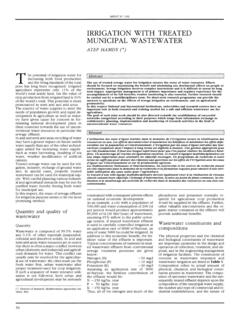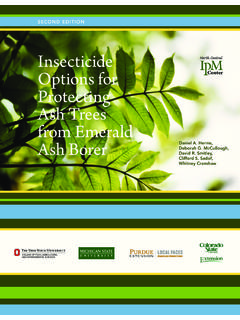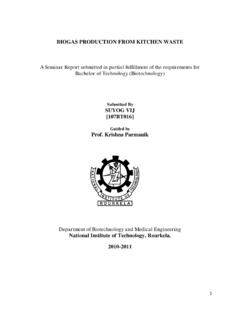Transcription of Status of Waste Management in Urban & Rural Areas
1 State of Environment Report Gujarat 2012 Urban , Rural & Built Environment 1 Status of Waste Management in Urban & Rural Areas Introduction Waste generation is an integral part of ecological cycle. Every element of ecosystem directly or indirectly produces Waste . With the advancement in human activities, inventions and discoveries, the quantum of Waste generation has gone high. It has not only increased in volume but also has become more and more complex in composition which cannot be decomposed completely through natural processes. Hence Waste Management becomes an important responsibility of all the stakeholders generating Waste and authorities managing human habitat and environment. This section aims at presenting the scenario of Waste Management in Gujarat. It covers all broad classifications of wastes, their Status of generation, collection, treatment and disposal, likely impacts and response mechanism of various stakeholders.
2 What is Waste ? Definition and types Wastes are materials which are discarded after use at the end of their intended life-span. (MoEF, Report of the Committee to Evolve Road Map on Management of Wastes in India, 2010) Waste can be categorized in various ways depending on their source of generation, physical state and composition to name a few. For the purpose of this study, Waste has been classified based on source of generation mainly Waste generated by domestic and allied activities both in Urban and Rural Areas and Industrial activities. Biomedical and E- Waste is generated in any of these locations Urban , Rural or industrial but they have been dealt with separately as there are separate rules that govern its Management and separate infrastructure exists in the state to manage these. 4 3 2 1 E- Waste Bio-Medical Waste Industrial Waste Domestic Waste Urban Waste Rural Waste Solid/Liquid (Non Hazardous) Waste Hazardous Waste State of Environment Report Gujarat 2012 Urban , Rural & Built Environment 2 The Waste can be classified on the bases of their physical state and composition into liquid Waste and solid Waste ; 1.
3 Liquid Waste : Liquid Waste means sludge resulting from, but not limited to, Waste treatment works, air pollution control facility, domestic, commercial, mining, institutional, agricultural, or governmental operations; or other Waste materials, including materials to be recycled or otherwise beneficially reused; or septic tank, grease trap, sediment trap, portable toilet, or oil and grease separator pump-outs; or solvents, sewage, industrial Waste , hazardous Waste , semisolid Waste , or potentially infectious Waste ; or any similar materials which would cause a nuisance if discharged to the ground waters. (Center of Excellence for Environmental Education, GoI) The solid by-products of sewage treatment are classified as sewage wastes or liquid Waste . They are mostly organic and derive from the treatment of organic sludge from both the raw and treated sewage. The inorganic fraction of raw sewage such as grit is separated at the preliminary stage of treatment, but because it entrains putrescible organic matter which may contain pathogens, must be buried/disposed off without delay.
4 The bulk of treated, dewatered sludge is useful as a soil conditioner but invariably its use for this purpose is uneconomical. The solid sludge therefore enters the stream of municipal wastes unless special arrangements are made for its disposal. (CPHEEO) 2. Solid Waste : Solid wastes are all the wastes arising from human and animal activities that are normally solid and are discarded as useless or unwanted. (Center of Excellence for Environmental Education, GoI) Solid Waste includes all types of Waste in municipal Waste category arising from human and animal activity and all residential, commercial and institutional categories of wastes discussed in the following sections can be defined as follows: "Municipal solid Waste "(MSW) includes commercial and residential wastes generated in municipal or notified Areas in either solid or semi-solid form excluding industrial hazardous wastes but including treated bio-medical wastes.
5 (MoEF, Municipal Solid Waste ( Management and Handling) Rules, 2000) MSW also includes construction and demolition Waste which is often mixed with the domestic Waste . This Waste has high potential for reuse and recycling and so need to be handled separately. Construction and demolition wastes are the Waste materials generated by the construction, refurbishment, repair and demolition of houses, commercial buildings and other structures. It mainly consists of earth, stones, concrete, bricks, lumber, roofing materials, plumbing materials, heating systems and electrical wires and parts of the general municipal Waste stream, but when generated in large amounts at State of Environment Report Gujarat 2012 Urban , Rural & Built Environment 3 building and demolition sites, it is generally removed by contractors for filling low lying Areas and by Urban local bodies for disposal at landfills.
6 (CPHEEO) Industrial Waste , as name indicates, it is purely contributed by industrial units. Its type and characteristic majorly depend on the type of industry, processing and raw materials. It can be broadly classified into industrial Solid/Liquid Waste and Hazardous Waste . Industrial Solid/Liquid Waste differs from Hazardous Waste in respect of their composition. This type of Waste has to be handled separately and requires different treatment from domestic Waste . It mainly contains ashes, chemicals, dyes, byproducts of the industry and heavy metals. Management of Industrial Solid Waste (ISW) is not the responsibility of local bodies. Industries generating solid Waste have to manage such Waste by themselves and are required to seek authorisations from respective State Pollution Control Boards (SPCBs) under relevant rules. However, through joint efforts of SPCBs, local bodies and the industries, a mechanism could be evolved for better Management .
7 (CPHEEO) Hazardous Waste means any Waste which by reason of any of its physical, chemical, reactive, toxic, flammable, explosive or corrosive characteristics cause danger or is likely to cause danger to health or environment, whether alone or when in contact with other wastes or substances, and shall include Waste specified in Schedule I, II & III of the Rules. (MoEF, Hazardous wastes ( Management , handling and Transboundary Movement) Rules, 2008) Hazardous wastes may be defined as wastes of industrial, institutional or consumer origin. In some cases although the active agents may be liquid or gaseous, they are classified as solid wastes because they are confined in solid containers. Typical examples are: solvents, paints and pesticides whose spent containers are frequently mixed with municipal wastes and become part of the Urban Waste stream.
8 Certain hazardous wastes cause explosions in incinerators and fires at landfill sites. Others, such as pathological wastes from hospitals and radioactive wastes, require special handling at all time. Good Management practice should ensure that hazardous wastes are stored, collected, transported and disposed off separately, preferably after suitable treatment to render them innocuous. (CPHEEO) Apart from Hazardous wastes generated from industrial Areas , households do contribute some of the wastes that are hazardous in nature, though they produce it occasionally. Wastes like aerosol canes, batteries from flash lights and button cells, bleaches and household kitchen and drain cleaning agents, car batteries, oil filters and car care products and consumables, chemicals and solvents and their empty containers, chemical based cosmetic items, ,insecticides and their empty containers, light bulbs, tube-lights and compact fluorescent lamps, paints, oils, lubricants, glues, thinners, and their empty containers, pesticides and herbicides and their empty containers, photographic chemicals, styrofoam and soft foam packaging from new equipment and mercury-containing products are considered as domestic Hazardous Waste and they are to be stored separately from Bio-degradable and recyclable domestic Waste in dedicated bins and disposed by municipal authority as per the Hazardous Waste Management Rules.
9 (CPHEEO) State of Environment Report Gujarat 2012 Urban , Rural & Built Environment 4 "Bio-medical Waste " means any Waste , which is generated during the diagnosis, treatment or immunisation of human beings or animals or in research activities pertaining thereto or in the production or testing of biologicals, and including categories mentioned in Schedule I of the Bio-Medical Waste Rules. (MoEF, Bio-Medical Waste ( Management and Handling) Rules, 1998).Biomedical Waste is mainly attributed to Waste from hospitals, medical clinics and laboratories. Biomedical Waste differs from other Waste because of its infectious nature which asks for specialized treatment. It mainly contains medicines, injections, cotton, decayed body parts, bottles and the like. E- Waste is electronic Waste which encompass wide range of electrical and electronic devices such as computers, hand held cellular phones, personal stereos, including large household appliances such as refrigerators, air conditioners, microwaves and many more.
10 E Waste means Waste electrical and electronic equipments, whole or in a part or rejects from their manufacturing and repair process, which are intended to be discarded. (MoEF, e Waste ( Management & Handling) Rules, 2011, 2011) Approach PressureIncrease in Waste Generation, Quality of Waste GeneratedStateAdequacy of scientific treatment and disposalImpactPollution of water bodies, landResponseMore investment, Improved coverage, treatment and disposalAwareness programmesDriving ForceUrbanization, Economic Development, Change in the Life Style, Figure 4. 1 - Conceptual Framework: Pressures, Impact & Response along the Value chain of Waste Management State of Environment Report Gujarat 2012 Urban , Rural & Built Environment 5 While increasing urbanization, industrialization, fast growing Rural Areas and changing lifestyles are widely accepted key drivers for Waste generation, the Pressures and Impacts are observed in different magnitudes across the value chain.


